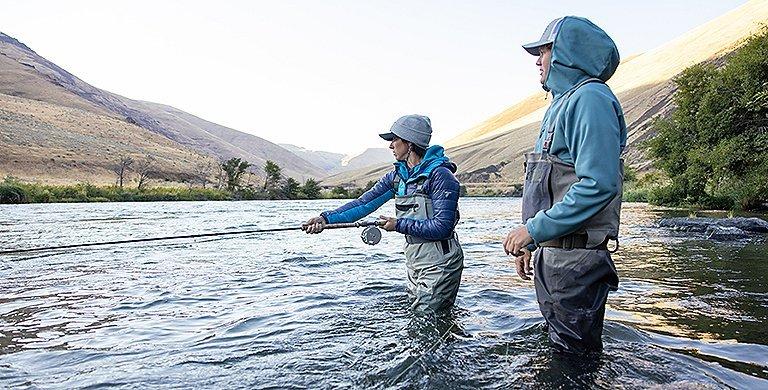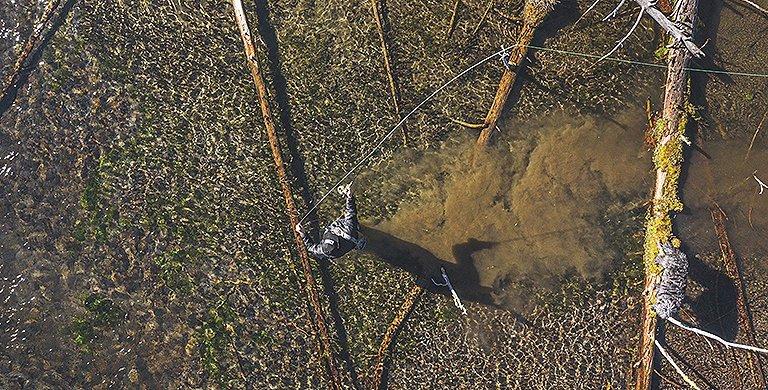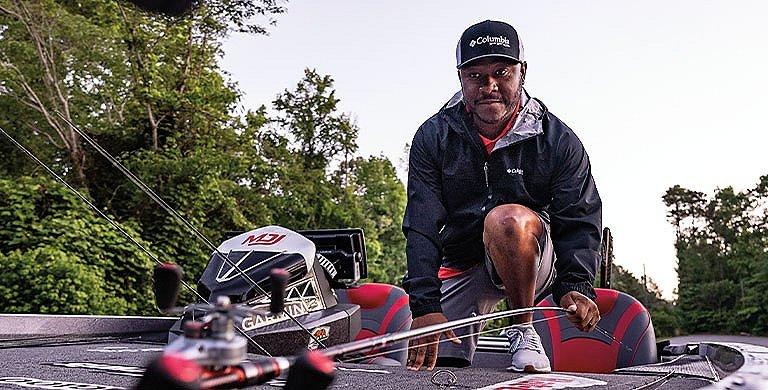FISHING
Fishing Tips and Techniques: Common Mistakes to Avoid
We asked pro angler Mark Daniels Jr. for more of his best advice on fishing techniques for beginning anglers
BY TROY ASPLUND & DAVID YOUNG
You’ve purchased some fishing gear, have a piece or two of fishing clothing in your closet and have gotten out on the water a handful times—maybe you’ve even landed a few fish. You're officially a bona fide beginning angler. But what if you don’t want to look like such a beginner?
Earlier this year, we shared some of the best tips for getting started fishing from pro angler Mark Daniels Jr., and now the accomplished athlete has agreed to join us again. This time he’s here to discuss some of the common beginner fishing mistakes and offer his own personal tips and techniques that will not only help you become a better angler but a more knowledgeable one as well.
Here are Daniels’ top seven fishing mistakes to avoid:
Earlier this year, we shared some of the best tips for getting started fishing from pro angler Mark Daniels Jr., and now the accomplished athlete has agreed to join us again. This time he’s here to discuss some of the common beginner fishing mistakes and offer his own personal tips and techniques that will not only help you become a better angler but a more knowledgeable one as well.
Here are Daniels’ top seven fishing mistakes to avoid:
1. Pulling or jerking the line too hard
Successfully landing a fish takes finesse. If you try to reel in a fish too forcefully—sometimes referred to as horsing the fish—you’ll more often than not lose that fish.
Daniels explains, “A mistake a lot of people make is trying to ‘horse the fish.’ They’ve got them and they’re trying to reel them in too fast. A lot of times that will cause your line to break, or the fish to pull the hook away and you lose it.” He further advises, “You need to stay calm and take your time.”
Daniels explains, “A mistake a lot of people make is trying to ‘horse the fish.’ They’ve got them and they’re trying to reel them in too fast. A lot of times that will cause your line to break, or the fish to pull the hook away and you lose it.” He further advises, “You need to stay calm and take your time.”
2. Being impatient
If you try rushing a fish, you likely won’t have a fish. Letting them properly take the hook takes patience, which Daniels says is essential.
“When the fish is just getting to the bait and starting to mess with it, you see a lot of action—what we call ‘taps.’ At that point, it’s just mouthing it, deciding if it’s good.” Daniels goes on to explain that waiting until the fish actually takes the bait is what really tries the patience of a beginning angler.
Daniels also explains that there’s one big difference between fishing with live bait versus artificial bait. With live bait, you really need to wait until you’re sure the fish has taken it. “A lot of people see the little nibbles and think they have it.” But you need to watch for the bait to disappear into the fish’s mouth. Trying to set the hook before that will just scare the fish away, Daniels warns. So how do you tell the difference between a bite and a nibble? Put simply, more fishing.
While you can often err on being overly patient when it comes to setting a hook with live bait, Daniels explains that isn’t the case with artificial bait. “If you’re using artificial bait, you can wait too long. Once the fish has bitten, it’s go time!” Because the instant they sense it’s not a real meal, they’ll spit it out and quickly leave your hook behind.
“When the fish is just getting to the bait and starting to mess with it, you see a lot of action—what we call ‘taps.’ At that point, it’s just mouthing it, deciding if it’s good.” Daniels goes on to explain that waiting until the fish actually takes the bait is what really tries the patience of a beginning angler.
Daniels also explains that there’s one big difference between fishing with live bait versus artificial bait. With live bait, you really need to wait until you’re sure the fish has taken it. “A lot of people see the little nibbles and think they have it.” But you need to watch for the bait to disappear into the fish’s mouth. Trying to set the hook before that will just scare the fish away, Daniels warns. So how do you tell the difference between a bite and a nibble? Put simply, more fishing.
While you can often err on being overly patient when it comes to setting a hook with live bait, Daniels explains that isn’t the case with artificial bait. “If you’re using artificial bait, you can wait too long. Once the fish has bitten, it’s go time!” Because the instant they sense it’s not a real meal, they’ll spit it out and quickly leave your hook behind.
3. Having the wrong gear
Fishing gear is about more than just looking good, says Daniels. The right fishing clothes make all the difference, especially when it comes to staying comfortable. Because when you’re out in the elements, whether it's the cold, sun, or rain, it’s going to take more than jeans and a cotton T-shirt to outlast the fish. So what should you wear while fishing?
“It all depends on the weather,” begins Daniels. On a spring or early summer day, Daniels prefers a long-sleeve PFG shirt—his favorite is the hooded Terminal Tackle Hoodie for its added protection. “That's my favorite shirt because it's cool and lightweight—even when it's super hot out, you still feel cool in it.” Daniels suggests adding a pair of PFG shorts or pants, and topping it all off with a hat . And with that, “You’re ready to roll.”
Performance Fishing Gear clothing is specifically designed to be out in the elements for long periods of time. They’re UPF-rated to protect you from the sun—better than sunscreen, according to recent studies. In addition to sun protection, they also have cooling technologies built into the fabric to prevent you from overheating while fishing, which Daniels says is key for all-day comfort.
“When I put on a shirt with technologies like Omni-Freeze™ ZERO or Omni-Freeze™ ZERO Ice, and that sun is beaming down with 80-, 90-, or even 100-degree temps, I can still perform and do what I need to do, especially in tournaments,” he adds.
Making sure you have the right footwear is just as important as what you’re wearing above the ankles. Daniels says the best fishing shoes allow you to maneuver safely and comfortably while keeping your footing in wet areas, from river banks to boat decks.
“It all depends on the weather,” begins Daniels. On a spring or early summer day, Daniels prefers a long-sleeve PFG shirt—his favorite is the hooded Terminal Tackle Hoodie for its added protection. “That's my favorite shirt because it's cool and lightweight—even when it's super hot out, you still feel cool in it.” Daniels suggests adding a pair of PFG shorts or pants, and topping it all off with a hat . And with that, “You’re ready to roll.”
Performance Fishing Gear clothing is specifically designed to be out in the elements for long periods of time. They’re UPF-rated to protect you from the sun—better than sunscreen, according to recent studies. In addition to sun protection, they also have cooling technologies built into the fabric to prevent you from overheating while fishing, which Daniels says is key for all-day comfort.
“When I put on a shirt with technologies like Omni-Freeze™ ZERO or Omni-Freeze™ ZERO Ice, and that sun is beaming down with 80-, 90-, or even 100-degree temps, I can still perform and do what I need to do, especially in tournaments,” he adds.
Making sure you have the right footwear is just as important as what you’re wearing above the ankles. Daniels says the best fishing shoes allow you to maneuver safely and comfortably while keeping your footing in wet areas, from river banks to boat decks.
4. Ignoring the rules
Make sure you know the regulations for where you’re fishing, especially how many and what size fish you can keep per day. Be prepared to show
fishing agents or wardens your catch if asked, to prove you are complying with the rules. And remember, ignorance is no excuse for having undersized fish or a catch that’s over the legal limit.
“A quick internet search will often let you know what the rules and regulations are per body of water," advises Daniels. “Search the place you’ll be fishing and it will tell you, for example, you can keep three salmon, five largemouth bass, five smallmouth bass, and they have to be X-amount of length in order to keep them.”
And if you do plan on keeping your catch, it’s important to bring along a measuring tool. Many coolers, especially those designed for fishing, include fish-measuring marks on them, says Daniels. But you can also get a fish measuring tool online or at most fishing or sporting goods stores.
“A quick internet search will often let you know what the rules and regulations are per body of water," advises Daniels. “Search the place you’ll be fishing and it will tell you, for example, you can keep three salmon, five largemouth bass, five smallmouth bass, and they have to be X-amount of length in order to keep them.”
And if you do plan on keeping your catch, it’s important to bring along a measuring tool. Many coolers, especially those designed for fishing, include fish-measuring marks on them, says Daniels. But you can also get a fish measuring tool online or at most fishing or sporting goods stores.
5. Waiting too long to put it on ice
If you’re keeping fish, you need to keep them fresh. The best way to do that is to get those fish on ice as soon as possible. Don’t worry about cleaning them until you get home—just get them off the hook and into an ice-filled cooler, says Daniels.
“The sooner you can get that fish on ice, the better you're going to preserve it and the better he's going to taste on the table,” he explains.
While Daniels definitely recommends having an ice chest for your catch, a stringer can work as a backup to keep your fish fresh. A stringer is a piece of rope, four or five feet long, that you can use to string the fish so you can keep them in the cool water until you’re ready to head home.
“The sooner you can get that fish on ice, the better you're going to preserve it and the better he's going to taste on the table,” he explains.
While Daniels definitely recommends having an ice chest for your catch, a stringer can work as a backup to keep your fish fresh. A stringer is a piece of rope, four or five feet long, that you can use to string the fish so you can keep them in the cool water until you’re ready to head home.
6. Being disrespectful
Whether fishing or taking part in any outdoor activity, always follow the Leave No Trace principles to minimize your impact on the environment, leaving the outdoors, including fishing areas, better than you found them. That often means picking up after careless individuals that were there before you.
Daniels adds, “People leave trash in some of these fishing spots and then before you know it, we can’t fish there anymore.” At the end of the day, littering and damaging the environment not only hurts the fish, it hurts the reputation of the sport you’re just getting into.
Daniels adds, “People leave trash in some of these fishing spots and then before you know it, we can’t fish there anymore.” At the end of the day, littering and damaging the environment not only hurts the fish, it hurts the reputation of the sport you’re just getting into.
7. Being overly focused on your catch
It’s called fishing, not catching. If you haven’t heard that before, you will. So in other words, don’t judge your day by how many fish you catch. Remember, there are no bad days fishing. You’re out on the water, enjoying nature for endless hours at a time—that sounds pretty good, doesn’t it?
“There are going to be many times when you go fishing and you don't catch anything,” says Daniels. “But be sure to keep that positive attitude and remember the whole reason you went out there to begin with.”
Daniels sums up by saying “Remember to have fun. That’s so important when you're doing this, especially in the beginning.” Happy fishing, everyone!
“There are going to be many times when you go fishing and you don't catch anything,” says Daniels. “But be sure to keep that positive attitude and remember the whole reason you went out there to begin with.”
Daniels sums up by saying “Remember to have fun. That’s so important when you're doing this, especially in the beginning.” Happy fishing, everyone!
Ready to get out and put your newfound fishing knowledge to use? First check out Columbia’s entire fishing collection.



